
Cactus Fruit: An Overview of Prickly Pear and Dragon Fruit
When we think of cacti, we often envision a desert landscape adorned with spines and, occasionally, flowers. But what if I tell you that these desert plants can produce delicious and juicy fruits?
The dragon fruit and the prickly pear are intriguing due to their unique appearance and sweet fruit. Both fruits have a rich heritage and offer numerous health benefits, making them a treat for the palate and the eyes.
In this article, we will learn the fascinating world of these two fruits, shedding light on their differences, similarities, origins, tastes, how to enjoy them, and the benefits they bring.
The Prickly Pear

Originating from the arid landscapes of the Americas, the Opuntia ficus-indica, called prickly pear (also known as cactus pear), is a love aliment in Mexican cuisine. Its exterior is anything but inviting, with a thick skin covered in spines and thorns. However, the interior tells a different story, revealing juicy, sweet flesh dotted with edible seeds. Prickly pears range in color from green, yellow, purple, and red fruit, each offering a slightly different flavor profile ranging from sweet to subtly tart.
The Dragon Fruit

The dragon fruit, or pitahaya (pitaya), hails from a different type of cactus. Native to Central America but now cultivated in many parts of the world, including Southeast Asia and Australia. Its name comes from its striking appearance: bright pink, scaly outer skin, and soft flesh speckled with tiny black seeds. The taste of dragon fruit is often described as a blend between a kiwi and a pear, with a mild sweetness and a refreshing, juicy texture. Pitahayas offers a wide range of varieties, colors, and flavors.
Similarities and Differences of These Cactus Fruits
While often mistaken for one another, the prickly pear cactus and the pitahaya are distinct, albeit related, treasures from the cactus family. The opuntia, native to Mexico, is born from the Stenocereus genus. This desert fruit thrives on rugged cacti, offering a dense, juicy flesh with a subtle sweetness. On the other hand, Dragon fruit is from the Hylocereus and Selenicereus genus of Central America. This climbing cactus boasts a vibrant exterior and delicate flesh.
Prickly pear fruits hold deep cultural significance in Mexico but are hard to find outside their original land. However, the dragon fruit found fame in Southeast Asia, becoming an agricultural and culinary star. Both fruits have rich and diverse cultures, but the difficulty of harvesting, importing, and conserving the Mexican fruit makes it inaccessible to most of the population.
Nonetheless, both fruits share the qualities of being incredibly hydrating and rich in vitamins and minerals, making them excellent choices for a healthy diet.
Taste and Culinary Uses

The taste of prickly pear is often likened to a combination of watermelon and bubblegum, making it a unique addition to beverages like lemonade, desserts, and salads. Dragon fruit, with its subtle sweetness, is perfect for eating raw, blending into smoothies or a cocktail, and adding a colorful touch to fruit salads and even a dessert.
How to Enjoy Them
Eating these fruits can be an adventure in itself. For prickly pear, the key is to carefully peel away the skin to avoid the spines, revealing the sweet pulp inside. Dragon fruit is more straightforward to prepare; cut it in half, scoop out the flesh, or peel off the skin and slice the fruit as desired. In both cases, you don't need to remove the seeds.
Nutritional Benefits

The fruits of these cactus species are low in calories yet packed with nutrients. Prickly pears are rich in fiber, antioxidants, and vitamin C, making them great for digestion and immune health. Dragon fruit stands out for its vitamin C, prebiotic fibers that promote a healthy gut, and a significant amount of magnesium, essential for muscle and nerve function.
Fun Facts
Did you know that prickly pear cacti are not only valued for their fruit but also for their ability to produce cochineal dye, a natural red pigment? Or that dragon fruit's flowers bloom overnight and are pollinated by bats and moths, adding to their exotic allure?
Conclusion
With their distinct flavors, textures, and health benefits, prickly pear and dragon fruit offer a delicious glimpse into the world of exotic fruits. Whether you're drawn to the desert-inspired sweetness of the prickly pear or the tropical freshness of the dragon fruit, both fruits are worth exploring for their nutritional value and unique taste profiles. So why not add a touch of the exotic to your diet and embark on a culinary adventure with these two fascinating fruits?
Roxanne - nordexotic.com
